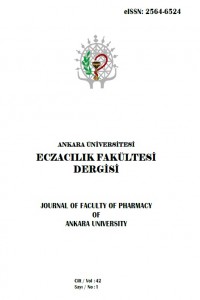The Journal of Faculty of Pharmacy of Ankara University is an international medium, an open access, peer-reviewed journal for the publication of original research reports, reviews and short communications in English or Turkish on relevant developments in pharmaceutical sciences., Proceeding of scientific meetings may be published as special issues of supplements to the journal. Additionally, it contains previous and forthcoming national and international scientific meetings with social activities in pharmaceutical areas.
GLİSİN İLE TİYOTRİAZOLİN SABİT KOMBİNASYONUNUN DENEYSEL SEREBRAL İSKEMİ ŞARTLARINDA BEYİN ENERJİ METABOLİZMASI GÖSTERGELERİNE ETKİSİ
Abstract
Amaç: Serebral iskemide primer nörokoruma uyarıcı ve inhibitor nörotransmiter sistemleri arasındaki
bozulan dengenin doğal inhibitor yolakların aktivasyonu ile düzeltilmesi yaklaşımına dayanır. Antioksidan bir
madde olan tiyotriazolinin nöro-metabolik serebral koruyucuların terapötik etkilerini arttırdığına ilişkin
kanıtlar bulunmaktadır. Bu nedenle glisin ve tiyotriazolini birlikte içeren yeni bir ilaç kombinasyonu oluşturmak
ilginç olabilir. Bu çalışmada glisinin, ve tiyotriazolin ile kombine kullanımının akut serebrovasküler bozukluk
(ASVB) oluşturulmuş rat modelinde hidrokarbon-enerji prosesleri ve oksidatif metabolizma parametreleri
üzerindeki etkilerinin araştırılması amaçlanmıştır.
Gereç ve Yöntem: ASVB, klasik yöntem olan ana karotis arterlerin simültane ligasyonu ile
gerçekleştirilmiş ve deneylerde 50 erkek Wistar rat kullanılmıştır. Uygulamalara gruplardaki ratlar anesteziden
çıktıktan hemen sonra intraperitonal olarak başlanmış ve 4 gün boyunca devam edilmiştir. Beyin kortekslerinde
adenil nükleotidler, piruvat, laktat, malat ve isositrat düzeyleri, suksinat dehidrogenaz, sitokrom C-oksidaz,
glutamat dekarboksilaz ve GABA-transferaz aktiviteleri biyokimyasal yöntemlerle saptanmıştır.
Sonuç ve Tartışma: Glisin ve tiyotriazolinin birlikte kullanımının, beyin enerji metabolizması
göstergeleri üzerine referans ilaçlar olan pirasetam ve glisinden daha etkili olması, bu kombinasyon üzerinde
araştırmaların devam etmesi gerekliliğini göstermektedir.
References
- Gusev, Е.I., Skvortsova, V.I. (2001). Brain ischemia, Medicine, Moscow, p.328.
- Mazur, I.А., Chekman, I.S., Belenichev, I.F. (2007). Metabolitotropic drugs, Pechatnyi Dom, Zaporozhye, p.309.
- Galenko-Yaroshevskiy, P.А., Chekman, I.S., Gorchakova, N.А. (2001). Essays on the pharmacology of metabolic therapy, Medicine, Moscow, p.240.
- Khizhnyak, А.А., Kursov, S.V. (2003). Participation of excitatory amino acid transmitters in the mechanisms of neurodestruction and perspective methods of pathogenetic correction. Pain Anesthetization and Acute treatment, 1, 43 – 46.
- Astakhov, А. (2004). Glycised-KMP: just amino acid or multipurpose anti stress medication? Ukraine Drugs, 1, 35 – 36.
- Gorchakova, N.А., Belenichev, I.F., Mazur, I.А. (2007). Mechanism of antioxidant and antiischemic action of thiotriazoline. Medicine Pharmacy News, 2(206), 11-21.
- Belenichev, І.F., Gorbachova, S.V., Golovkin, V.V., Bukhtiyarova, N.V. (2006). Influence of the composition “Magnelong”, glycine, emoxipine and piracetam on the development of oxidative stress in the brain of rats with acute cerebrovascular disorders (ischemic stroke). Medical Chemistry, 3, 107-110.
- Mazur, I.A., Chekman, I. S., Belenichev, I.F., Gorchakova, N.А. (2011). Development of drugs based on fixed combinations with antioxidants - a promising area of modern pharmacology. Pharmacology and Drug Toxicology, 5, 199–200.
- Kozhemyakin, Y.М., Khromov, О.S., Filonenko, М.А., Sayftedinovna, G.А. (2002). Scientific and methodical recommendations for the maintenance of laboratory animals and work with them. Avitsena Kiev, p.156.
- Voronina, Т.А., Seredinin, S.B. (2002). Manual on experimental (preclinical) study of new pharmacological substances, Information and analytical portal of the Ministry of Health of the Russian Federation ZAO “Remedium”, p.320.
INFLUENCE OF THE FIXED COMBINATION OF GLYCINE WITH THIOTRIAZOLINE ON ENERGY METABOLISM PARAMETERS IN BRAIN IN CONDITIONS OF EXPERIMENTAL CEREBRAL ISCHEMIA
Abstract
of the imbalance of excitatory and inhibitory neurotransmitter systems by activating natural inhibitory
processes. There is evidence of the ability of anti-oxidant thiotriazoline to potentiate the therapeutic effect of
neuro-metabolic cerebroprotectors. Therefore, it is interesting to create a new combined drug based on glycine
and thiotriazoline. The purpose of this study is to investigate the effect of glycine, as well as its combination
with thiotriazoline, on the parameters of hydrocarbon-energy processes and oxidative metabolism under the
conditions of simulation of acute cerebrovascular disorder (ACVD).
carotid arteries was used in 50 Wistar male rats. All drugs were administered intraperitonally for four days
starting with anesthesia recovery of rat groups. The content of adenyl nucleotides, pyruvate, lactate, malate,
isocitrate and activities of succinate dehydrogenase, cytochrome C-oxidase, glutamate decarboxylase, GABAtransferase were determined in the homogenates of brain cortex by biochemical methods.
than such reference drugs like pyracetam and glycine, according to degree of effect on the indicators of energy
metabolism of the brain, indicating the relevance of further study of the proposed combination.
References
- Gusev, Е.I., Skvortsova, V.I. (2001). Brain ischemia, Medicine, Moscow, p.328.
- Mazur, I.А., Chekman, I.S., Belenichev, I.F. (2007). Metabolitotropic drugs, Pechatnyi Dom, Zaporozhye, p.309.
- Galenko-Yaroshevskiy, P.А., Chekman, I.S., Gorchakova, N.А. (2001). Essays on the pharmacology of metabolic therapy, Medicine, Moscow, p.240.
- Khizhnyak, А.А., Kursov, S.V. (2003). Participation of excitatory amino acid transmitters in the mechanisms of neurodestruction and perspective methods of pathogenetic correction. Pain Anesthetization and Acute treatment, 1, 43 – 46.
- Astakhov, А. (2004). Glycised-KMP: just amino acid or multipurpose anti stress medication? Ukraine Drugs, 1, 35 – 36.
- Gorchakova, N.А., Belenichev, I.F., Mazur, I.А. (2007). Mechanism of antioxidant and antiischemic action of thiotriazoline. Medicine Pharmacy News, 2(206), 11-21.
- Belenichev, І.F., Gorbachova, S.V., Golovkin, V.V., Bukhtiyarova, N.V. (2006). Influence of the composition “Magnelong”, glycine, emoxipine and piracetam on the development of oxidative stress in the brain of rats with acute cerebrovascular disorders (ischemic stroke). Medical Chemistry, 3, 107-110.
- Mazur, I.A., Chekman, I. S., Belenichev, I.F., Gorchakova, N.А. (2011). Development of drugs based on fixed combinations with antioxidants - a promising area of modern pharmacology. Pharmacology and Drug Toxicology, 5, 199–200.
- Kozhemyakin, Y.М., Khromov, О.S., Filonenko, М.А., Sayftedinovna, G.А. (2002). Scientific and methodical recommendations for the maintenance of laboratory animals and work with them. Avitsena Kiev, p.156.
- Voronina, Т.А., Seredinin, S.B. (2002). Manual on experimental (preclinical) study of new pharmacological substances, Information and analytical portal of the Ministry of Health of the Russian Federation ZAO “Remedium”, p.320.
Details
| Primary Language | English |
|---|---|
| Subjects | Pharmacology and Pharmaceutical Sciences |
| Journal Section | Research Article |
| Authors | |
| Publication Date | January 31, 2018 |
| Submission Date | December 20, 2017 |
| Published in Issue | Year 2018 Volume: 42 Issue: 1 |


